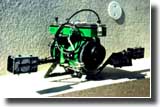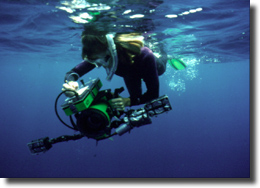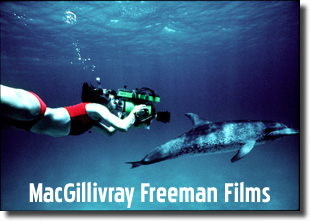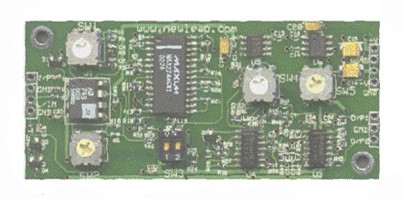The Mobile Video/Acoustic System – MVA
(a.k.a. “array”)
The mobile video/acoustic system (MVA) was developed to permit real-time synchronous recording of the sounds and behaviors of individual, free-swimming dolphins. Manually operated under water, the system consists of two omni-directional hydrophones cabled through a custom underwater housing into a stereo video camera. Hydrophone spacing on the housing is scaled to the human inter-aural distance based upon the speed of sound in water (4.5 times faster than in air). Location of the vocalizing dolphin is based upon associating visual distribution of animals with directions to sound sources as determined by aural psycho-acoustics.
Dudzinski and Gregg both used an ECD – echolocation click detector – that was added to the original design in a small second housing containing a digital audio (or recently an M-Audio) recorder together with a pre-processor circuit that allowed detection of the highly directional part of a dolphin’s echolocation ‘clicks’ and makes these audible and recordable. 
Dudzinski affectionately calls the MVA her “array” – since it contains at least two hydrophones.
Significance & Application
Observations of dolphin behavior are enhanced through the use of video recordings; valuable information is preserved and the dynamics of inter-animal relations, associations, behavior, and sociality can be examined. These data can be analyzed for evidence of acoustic, visual, and tactile signal exchange and behavioral coordination within varying social contexts. More importantly, comparisons of specific behaviors between individuals and groups of dolphins  are facilitated. Video recordings are especially useful for documentation, and subsequent analysis, of subtle within-group signaling of dolphins underwater, where they spend over 85% of their time. Inter-observer reliability is also possible from videotaped records, thus providing a set of observations able to withstand the rigors of statistical machinations. Video records enable an examination of visually and acoustically described behavior that provide insight on the importance of contextual cues for how dolphin signal-receivers respond to signalers. Conclusions may then be drawn concerning the interplay between vocalizations, social behavior, and contextual variables.
are facilitated. Video recordings are especially useful for documentation, and subsequent analysis, of subtle within-group signaling of dolphins underwater, where they spend over 85% of their time. Inter-observer reliability is also possible from videotaped records, thus providing a set of observations able to withstand the rigors of statistical machinations. Video records enable an examination of visually and acoustically described behavior that provide insight on the importance of contextual cues for how dolphin signal-receivers respond to signalers. Conclusions may then be drawn concerning the interplay between vocalizations, social behavior, and contextual variables.
In summer 2001, DCP increased the capability of our click detector (ECD) by adding a second frequency range. We use two circuit boards – one set at 70 kHz and one set at 120 kHz. This allows greater range to better determine how dolphins use their click (i.e., pulsed) sounds. The ECD boards were designed by Paul Lepper and Daryl Newborough of New Leap Ltd.
The following is the Abstract from Dudzinski et al’s presentation at the 30th Annual Meeting of the European Association for Aquatic Mammals held from 8-11 March 2002 in Aalborg, Denmark. For more information on the symposium program, go to www.eaam.org.
An examination of two frequency bands for echolocation click signals recorded from two species of wild dolphins with respect to behavior and potential function
Kathleen M. Dudzinski1, Paul Lepper2,3, Darryl Newborough3
1Dolphin Communication Project, 3600 S. Harbor Blvd., #429, Oxnard, CA 93035 USA
2Scripps Institute of Oceanography, Marine Physical Laboratory, Bldg. 4, San
Diego, CA 92106 USA
3New Leap Ltd., United Kingdom
ABSTRACT
Dolphin echolocation signals from two frequency bands have been processed for
both wild bottlenose (Tursiops truncatus) and Atlantic spotted dolphins
(Stenella frontalis) recorded around Mikura Island, Japan and in the Bahamas,
respectively. These data are closely correlated with underwater video footage
showing animal behavior around the acoustic receivers. Echolocation signals
were detected for both species using a single wide-band hydrophone (-164 dB
re 1V/uPa) and then processed in-situ using an envelope detection technique
for energy content in two frequency bands centered on 70 kHz and 120 kHz.
Each band had an approximate 15 kHz bandwidth with good rejection of energy
between each band. This method allowed detailed analysis of variations in
inter-click period for particular behaviors and changes in the click energy
spectral distribution between the two frequency bands of interest. Variations
in click rate are seen in both bands and appear to be correlated with changes
in behavior. The shift in energy between frequencies is potentially related
to specific dolphin head movements (e.g., head scanning); however, other
behaviors were also concurrently documented with observed shifts in energy
between both bands. This suggests that dolphins are capable of voluntary
control over the energy content and repetition rate of high frequency click
signals leading to the potential for communication among group members as one
function for click signals.

